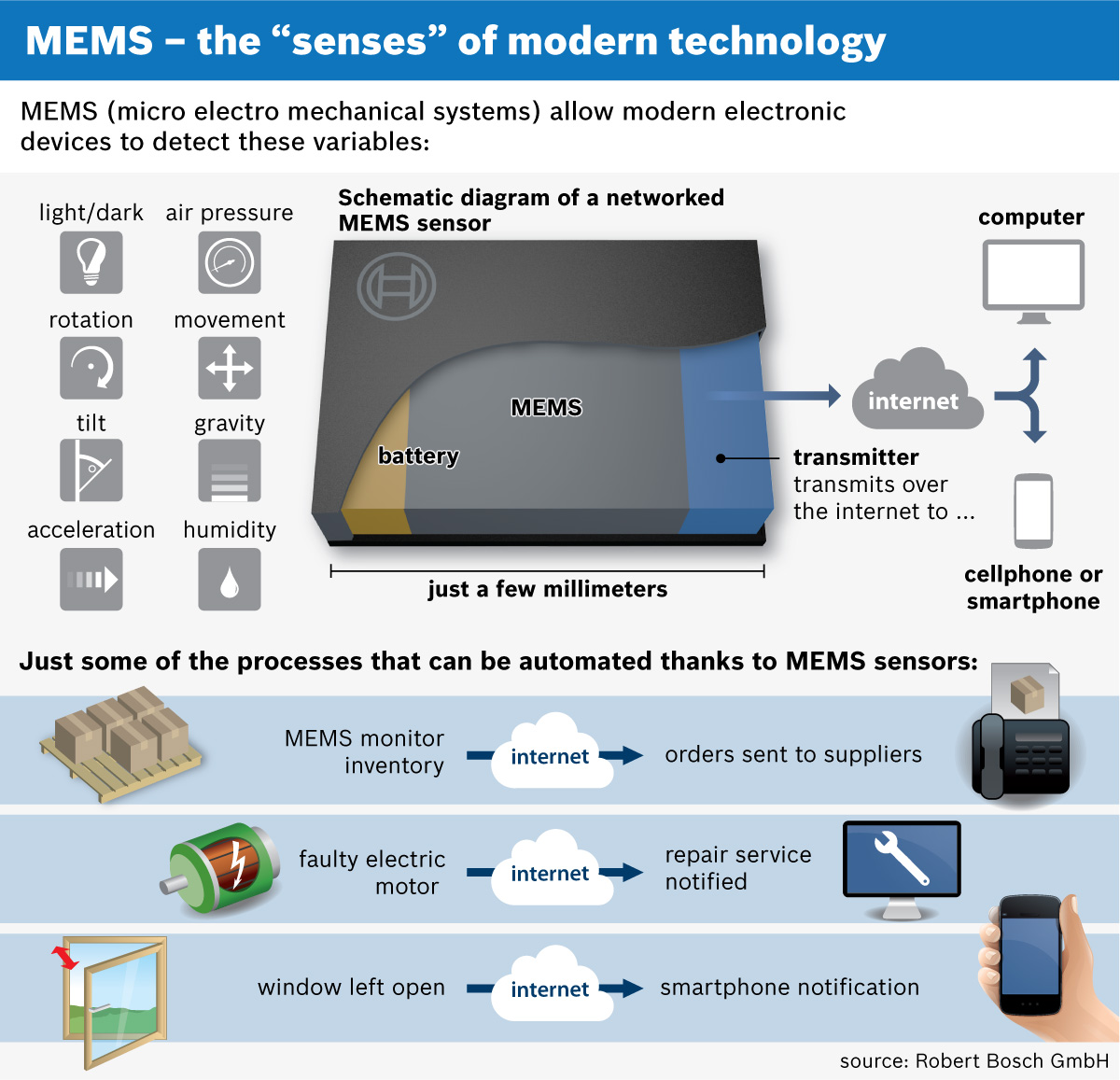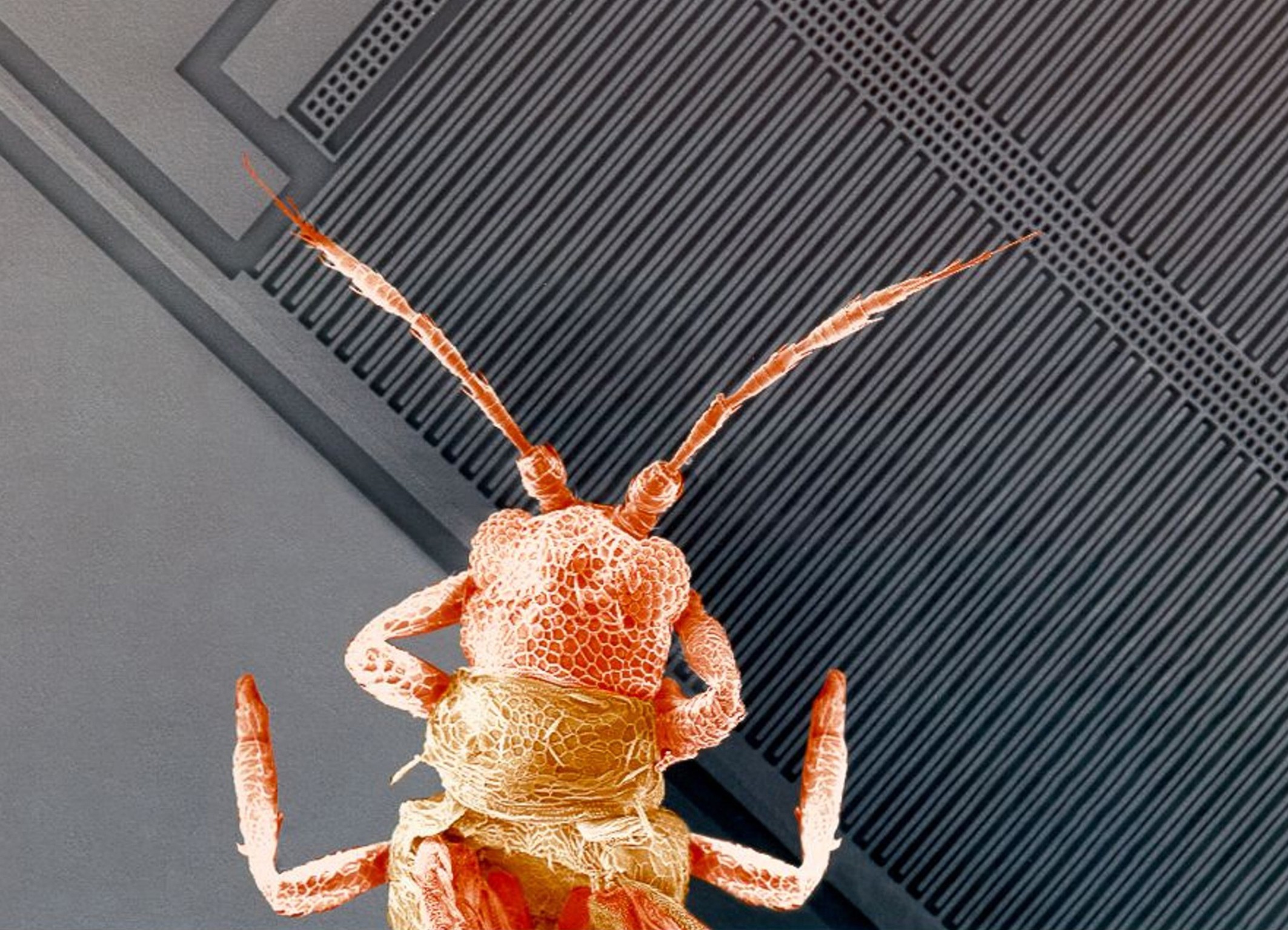Bosch at the 2014 CES in Las Vegas, January 7-10

Bosch is helping to build the internet of things and services one tiny sensor at a time. In future, many objects will report their status over the net, and this makes a range of new functions and business models possible. They contain microscopic structures that are capable of measuring acceleration, air pressure, sound, temperature, or the earth’s magnetic field. Fitted with a miniature battery and a tiny radio interface, these MEMS sensors can for instance send their readings over the internet to a user’s smartphone.
Stuttgart/Las Vegas – Bosch is helping to build the internet of things and services one tiny sensor at a time. In future, many objects will report their status over the net, and this makes a range of new functions and business models possible. At the Consumer Electronics Show (CES) in Las Vegas, Bosch will be presenting its tiny building blocks for connected living, along with possible applications. Known as MEMS (micro-electro-mechanical systems) sensors, they are no more than a few millimeters in size but hold enormous potential. They contain microscopic structures that are capable of measuring acceleration, air pressure, sound, temperature, or the earth’s magnetic field. Fitted with a miniature battery and a tiny radio interface, these MEMS sensors can for instance send their readings over the internet to a user’s smartphone. In theory, they allow any object in everyday use to connect to the internet so it can report on its status at any time on request – an ability that holds out plenty of promise for future applications.
Bosch sensors enable smartphones to feel
MEMS sensors have long been the sensory organs for many of the mobile devices that are presented in their thousands at the world’s biggest consumer electronics show. Bosch sensors enable modern electronic devices such as smartphones to “feel” and “hear” – so a smartphone “knows” how it is being held and whether it needs to rotate the image on its display. Meanwhile tiny MEMS microphones can record sounds and speech. The sensors are also applied in notebooks, tablets, smart watches, games consoles, or sports watches. Freight forwarding companies also stand to benefit, since such sensors will allow parts in storage in the warehouse to announce their number and location over the internet. Meanwhile, acceleration sensors affixed to delicate machinery will be able to confirm at any time that there has been no exposure to vibrations during transportation. What is more, if a crate fitted with such a sensor falls to the ground, the sensor can send out a warning email to a company headquarters anywhere in the world thanks to the internet.
“It’s simply a question of when”
“The question now is not whether the real and virtual worlds will merge thanks to sensors such as these. It’s simply a question of when,” says Dr. Volkmar Denner, chairman of the board of management of Robert Bosch GmbH. “Sensors, batteries, and transmitters can now be combined in a single unit that is so small, energy-efficient, and inexpensive that they can be put to work in their billions. At the same time, mobile data and radio networks are accessible from almost everywhere. This means the foundations are already in place for the internet of things and services.”
Bosch supplies sensors for a wide range of applications in the automotive and consumer electronics industries. Bosch has been at the forefront of MEMS technology since it first emerged, and today it generates more sales in this market than any other supplier. Since the start of production in 1995, the company has manufactured well in excess of three billion MEMS sensors. In 2012, some 600 million sensors emerged from its state-of-the-art wafer fab in Reutlingen – or 2.4 million each working day. Now every second smartphone worldwide uses Bosch sensors.
“These networked sensors make it possible to recognize and interact with the surroundings. A whole range of new solutions will emerge, offering more comfort, safety, and energy efficiency – and saving users‘ time and money,” says Dr. Dirk Hoheisel, who sits on the Bosch board of management. “As of today, there’s no limit to the new applications, functions, and business models that our sensors will allow. We see huge potential here.”

This image provided by a scanning electron microscope (SEM) shows the finely etched silicon structure of a Bosch acceleration sensor. The insect pictured here with the chip is included to give a sense of scale. The long silicon structures running diagonally across this image are designed to measure acceleration and are some 500 micrometers in length and only around 3 micrometers thick. A micrometer is one thousandth of a millimeter (0.001 mm). The insect’s antennae are also around 500 micrometers long. This image was tinted later using a computer.
Connected to the world
MEMS sensors were originally developed for use in cars, for instance in skid detection for the ESP® electronic stability program. Today each modern vehicle is home to up to 50 of MEMS sensors. They support significant safety and comfort functions such as “Adaptive Cruise Control” (ACC) or softer gear changing of automatic gearboxes. All these sensors have turned cars into suppliers of data for what is known as the automotive cloud, which is already providing drivers with valuable additional information in various situations and connecting them ever more closely to the world in real time.
Security and comfort anywhere, anytime
At the CES, Bosch will be presenting how sensors are a key enabler of the Internet of Things and Services. A network of wireless sensors will constantly gather and report information about the immediate environment. Users can learn which doors are open or closed, how loud it is, and how the temperature, air pressure, and humidity at various points around the booth changed over the course of the day. An automatic vacuum cleaner featuring MEMS sensors and an integrated WiFi module continuously reports its position. Thanks to these combined sensors, the Bosch booth will showcase how devices connected to each other via sensors continuously exchange and provide useful information. Bosch recently announced that it will work together with ABB, Cisco and LG on an open standard to support a software platform for the smart home of the future.
In-vehicle infotainment, electric vehicle charging, and more
In addition to MEMS sensors, Bosch will demonstrate technologies enabling the connected vehicle, including next-generation telediagnostics, electric vehicle charging, in-vehicle infotainment and driver assistance systems. Bosch is sponsoring the “Driverless Car” experience at CES 2014, where the milestones toward driverless mobility will be explored and demonstrate technologies such as automatic park assist, predictive emergency braking and “mySPIN” smartphone integration in a designated area outside the fair. The company will also illustrate several areas of competence, including eBikes to inverters for energy storage, start-stop vehicles to HD video surveillance and intrusion control to net-zero enabling thermotechnology.
Bosch booth at the 2014 CES
Las Vegas Convention and World Trade Center (LVCC),
South Hall 1, Stand 20812
